꿈과 로망의 세계유산
5/13
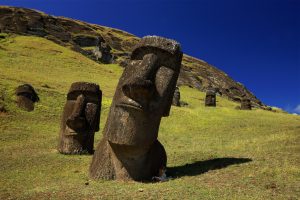
지구에서 가장 외딴섬 ‘절해 고도’ 이스터섬. 약 900구의 모아이 석상이 자리 잡고 있는 이 아름다운 섬은 전 세계 사람들의 마음을 사로잡습니다. 미스테리한 석조 문명에서 탄생한 이스터섬의 매력을 알고 나면, 세계일주 크루즈여행에서 가장 기대되는 기항지로 이 섬의 이름을 꼽는 분들이 많은 것도 수긍이 갑니다. 이스터섬을 사랑해 마지 않는 세계 유산 마이스터 가타오카 히데오 씨에게 그 매력에 대해 들어보았습니다.
'거대한 토지'에 펼쳐진 남국(南国)답지 않은 특이한 기후
1722년 부활절(이스터), 네덜란드인 야콥 로베겐이 이 섬을 발견했다고 하여 이스터섬이라는 이름이 붙은 곳. 현지어로는 ‘라파누이(큰 땅)’라고 불립니다. 섬을 중심으로 반경 2,000km 이내에는 거의 섬다운 섬이 없어 세계에서 가장 동떨어진 ‘절해 고도’입니다. 하지만 다르게 말하면 이 섬은 광활한 바다를 가지고 있다고 할 수도 있습니다. 이것이 바로 이스타섬이 '거대한 토지'라고 불리는 이유입니다.
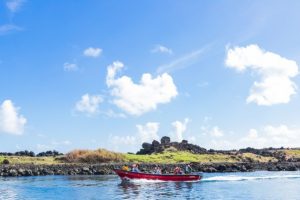
이스터 섬에는 큰 배가 정박할 수 있는 항구가 없기 때문에, 배는 앞바다에 닻을 내리고 텐더 보트를 이용해서 상륙합니다. 상쾌한 바람이 뺨을 스치고 이따금씩 파도를 맞으며 나아가는 텐더보트는 상쾌함 그 자체. 섬이 가까워질수록 가슴도 설레입니다.
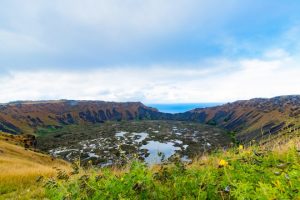
이스터섬은 해저 화산 3개에서 용암이 분출하여 생긴 화산섬으로, 바다 바로 근처에 위치한 라노카우 화산 화구호에는 웅장한 풍경이 펼쳐져 있습니다.
쓰러진 모아이 석상이 말해주는 과거
이스터섬을 세계적으로 유명하게 만든 것은 뭐니뭐니해도 모아이 석상의 존재입니다.모아이는 조상들의 모습을 우상화한 것이라고 알려져 있으며, 마을의 주거지를 지켜보는 모습으로 세워졌습니다. 그래서 대부분의 모아이는 바다를 등지고, 섬 안쪽을 향해있지요. 현재 남아 있는 모아이 석상 중 서 있는 것은 45구 정도. 나머지는 모두 쓰러졌거나 제작 중이 상태로 방치되어 있습니다. 1722년 야콥 로베겐이 이스터섬을 처음으로 방문했을 때 모아이상은 서 있었다는 기록이 남아 있습니다. 그러나 그 52년 뒤 캡틴 쿡이 이곳을 방문했을 때는 모아이 석상의 절반이 쓰러져 있었습니다. 지난 반세기 동안 이스터섬에서 도대체 무슨 일이 일어난 걸까요? 쓰러져 있는 모아이는 모두 아래를 향하고 있습니다. 이 점이 바로 수수께끼를 푸는 열쇠입니다.
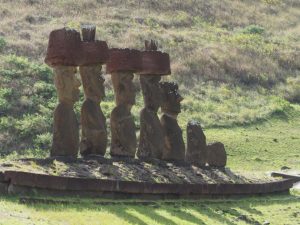
아나케나 해변에 늘어서 있는 ‘아후나우나우’라 불리는 7구의 모아이 석상들. 오랫동안 모래에 묻혀 있었기 때문에 보존상태가 좋으며, 모자라고도 묶은 머리라고도 불리는 ‘푸카오’까지 아름다운 모습으로 남아있습니다.

모아이 제조공장 '라노라라쿠'. 큰 산의 경사면에는 가슴속까지 땅에 파묻혀 있는 모아이나, 바위에서 깎이는 중인 모아이 등 이 장소에서만 볼 수 있는 다양한 모아이를 만날 수 있습니다.

조금 떨어진 언덕 위에 홀로 자리 잡은 ‘여행하는 모아이’는 1970년 오사카 엑스포 때 일본으로 옮겨져 전시되었습니다. 일본에 왔다는 것만으로도 신기하고 친근감이 생깁니다.
변해가는 섬과 거석문명의 정점
원래 화산섬이라 바위 투성이였던 섬은 철새들이 나른 씨앗에 의해 서서히 녹지화되어 오랜 세월에 걸쳐 숲이 형성되었습니다. 그런데 이곳에 인간이 살기 시작하면서 생활을 위해 숲을 개척했습니다. 그리고 모아이 석상을 만들기를 위해, 혹은 모아이 석상을 운반하기 위해서 나무를 자른 결과 삼림은 서서히 사라져 갔습니다. 결국 지나친 개간으로 식량 생산이 감소하고 식량은 부족하여 부족 간의 다툼으로 번지게 되었습니다. 많은 부족들이 힘을 과시하기 위해 경쟁하듯 모아이를 거대한 모아이 석상을 양산하기 시작했습니다. 전쟁에서 사람들은 각 부족의 세력의 상징인 모아이를 쓰러뜨렸습니다. 모아이의 눈에는 '마나'라는 성스러운 힘이 깃든다고 여겨져 사람들은 그것을 두려워했습니다. 이것이 ‘모아이 쓰러뜨리기 전쟁’이라고 불리는 싸움이며 대부분의 모아이 석상이 쓰러져 있는 이유입니다.
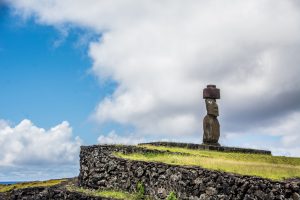
섬에서 유일하게 눈이 복원된 ‘아후 코크리쿠’의 모아이. 과거 섬 사람들이 영력을 느꼈던 모아이 석상의 원래 모습을 볼 수 있습니다.
모아이가 지켜보는 문명의 미래
천년에 이르는 석조문명은 정점을 맞이했을 때 단번에 무너져내렸습니다. 한 학자는 그 이유를 '문명의 폭주'에서 찾고 있습니다. 예를 들어 현대인의 생활은 PC나 스마트폰과 밀접하게 연결되어 있습니다. 하지만 이것들을 포기하고 원시 시대의 생활로 돌아가려고 해도 쉽게 돌아갈 수 있는 것은 아닙니다. 마찬가지로 모아이 석상을 대량 생산하고 점점 거대하게 만들어간 이스터섬 사람들 또한 한번 키운 모아이 크기를 줄이려 하지 않았습니다. 돌이켜보면 우리가 살고 있는 문명사회에도 마찬가지 아닐까요? 지구환경이 악화일로를 걸으며 온난화가 가속화되고 있다는 사실을 인식하면서도 우리 또한 지속가능성을 도외시한 편리성의 추구를 멈추지 못하고 있습니다. 외딴섬에 자리잡은 모아이 석상들은 잃어버린 문명 그리고 자연이 유한하다는 것을 호소하는 것만 같습니다.
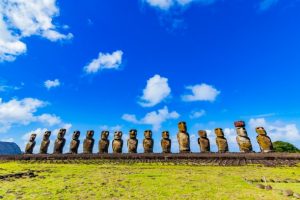
열 다섯 구의 모아이가 늘어선 ‘아후통가리키’. 영고성쇠의 역사를 조용히 지켜봐온 모아이 석상은 앞으로도 섬과 인류의 미래를 지켜볼 것입니다.
